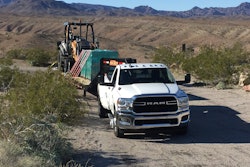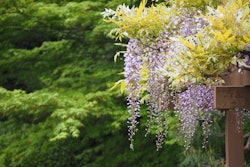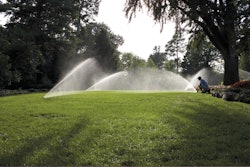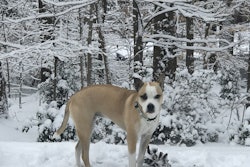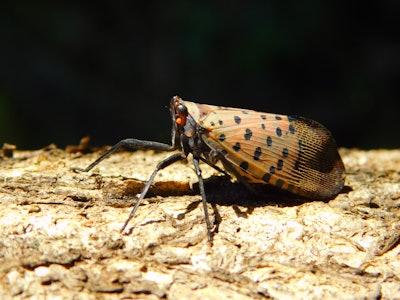 Spotted lanternfly (Lycorma delicatula) is native to southern Asia and was discovered in Berks County, Pennsylvania, in 2014.
Spotted lanternfly (Lycorma delicatula) is native to southern Asia and was discovered in Berks County, Pennsylvania, in 2014.Photo: Don Grosman
U.S. Secretary of Agriculture Sonny Perdue signed a national proclamation marking April as Invasive Plant Pest and Disease Awareness Month and one particular invasive species that is gaining attention as it becomes more problematic is the spotted lanternfly.
Spotted lanternfly (Lycorma delicatula) is native to southern Asia and was discovered in Berks County, Pennsylvania, in 2014.
According to Don Grosman, Ph.D., technology advancement manager and entomologist at Arborjet, the spotted lanternfly was brought into the U.S. on accident after a company that works with rocks imported some rocks from China that had egg masses on them.
“That particular site had a lot of Ailanthus in the area, so when the eggs hatched the crawlers went out and found some Alianthus and they survived and began to reproduce,” Grosman says. “They suspect that the rocks were imported in 2012, but they didn’t actually identify the insect until 2014.”
Now, there are established populations of spotted lanternfly in Pennsylvania, Virginia, New Jersey, Delaware and Maryland. Individual dead specimens have been found in New York, Connecticut and Massachusetts so far.
What’s the threat?
Unlike emerald ash borer (EAB), spotted lanternflies are not nearly as selective when it comes to which plant species they will feed on. This insect is known to feed on more than 70 plant species including grapes, orchard fruits, nut trees, maple and more. It does, however, have favored food sources, particularly tree of heaven (Ailanthus altissima).
 Honeydew produced by spotted lanternflies results in sooty mold appearing.
Honeydew produced by spotted lanternflies results in sooty mold appearing.Photo: Don Grosman
“There’s five different trees that they really like,” Grosman says. “Of course, tree of heaven is number one. Walnut is pretty close to tree of heaven in its preference, then silver maple, river birch and elm to a certain extent. These last three are somewhat less but they do congregate on those trees and produce a lot of honeydew when they are feeding.”
The honeydew spotted lanternflies produce leads to one of the main problems these invasive insects are responsible for. Sooty mold will often appear on plants covered in honeydew, coating leaves, stems and trunks in a black, powdery substance. While it does minimal harm to the plant, blocking sunlight and occasionally stunting its host, it can quickly coat the majority of the plant in a matter of days or weeks, becoming a major cosmetic issue.
“Primarily, it’s a quality of life issue for my customers,” says Brian Walsh, owner of Salix Springs Landscaping, based in Barto, Pennsylvania. “It’s something you really have to experience to appreciate what it’s like when they’re in high numbers. You can’t even walk out of the house without getting hit in the head with them.”
Additionally, the health of the plant the lanternfly decides to feed is also a concern. While spotted lanternfly usually doesn’t cause a lot of tree mortality, it can cause branch dieback.
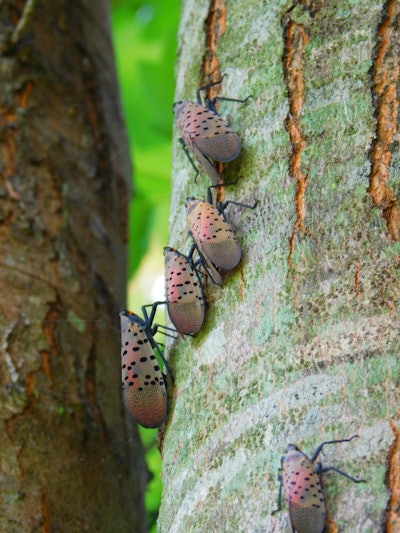 Adult spotted lanternflies prefer to target healthy tree hosts.
Adult spotted lanternflies prefer to target healthy tree hosts.Photo: Don Grosman
“The insect needs healthy trees,” Grosman says. “It has very poor musculature when it comes to sucking sap out of the trees. It relies more on the tree to bring the sap to it rather than to draw the sap out of the tree under pressure. The tree needs to be healthy and actively transporting sap through the tree so the insect can access it.”
As the tree starts to decline, the spotted lanternfly will move on, allowing it to recover. Yet once the tree does improve, the insect can return to feed again, creating a vicious cycle.
“There is the possibility that these feeding sites, the piercing of the proboscis into the trees, are creating wound sites that allow the introduction of other pathogens,” Grosman says.
They can definitely kill younger trees and plants if fed upon in a very short period of time. A big concern is what will happen if spotted lanternfly begins to vector a disease pathogen.
“If this thing manages to pick up a virus and start transferring it, then all bets are off,” Walsh says. “It’s bad because the adults are moving tree to tree, species to species in one lifetime and they’re heavy feeders. The way that they feed, if they start transmitting disease like that, we’re in really deep trouble.”
How to identify spotted lanternfly
The spotted lanternfly has five stages of growth after hatching from eggs. Egg masses have 30 to 50 eggs, which typically hatch in late April to early May. Spotted lanternfly eggs are about an inch long and can be laid on any hard surface including trees, stones, patio furniture and more.
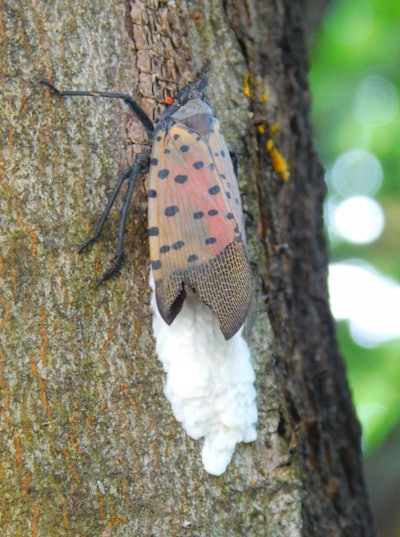 An adult spotted lanternfly lays a new egg mass.
An adult spotted lanternfly lays a new egg mass.Photo: Don Grosman
When freshly laid, it is covered in a white putty-like substance that eventually looks like dried mud. Over time, the egg mass develops into vertical rows of seed-like egg cases. In the first through third instar, nymphs grow from a few millimeters to ¼ inch long. These have black bodies and legs and are covered in bright white spots. They are incapable of flight, but they are strong jumpers.
The nymphs reach the fourth instar around July and are bright red with black stripes and white spots. They are ½ an inch long and are also strong jumpers.
The adults are about 1” to 1 ¼” long and have grey wings with black spots. The hind wings have patches of red and black with a white band. The head and legs are black while the abdomen is yellow with black bands. The females tend to be slightly larger than the males.
The adults will begin to lay eggs in September and continue until they die off in December. The adults are capable of flying but prefer to jump or glide instead.
Signs of a tree being fed upon include oozing or weeping and a fermented odor, buildup of honeydew on the tree and underneath it and sooty mold appearing on the infested tree.
“The primary thing is you really can’t appreciate what it’s like until you’re in a full infestation is when a tree looks like it’s raining because of the excrement coming out on a sunny day and you have to put on a raincoat to treat the tree,” Walsh says. “That’s how bad it can get.”
Control methods
When it comes to dealing with spotted lanternfly, it is important to have a game plan on how your company will respond, whether or not it has been found in your state yet.
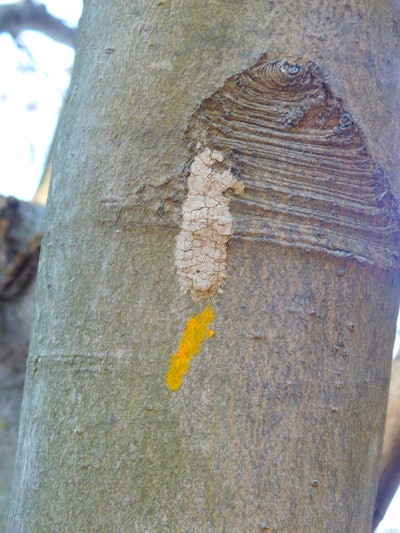 Egg masses have a dried mud appearance as they overwinter.
Egg masses have a dried mud appearance as they overwinter.Photo: Don Grosman
“(The) main thing is being knowledgeable about the insect and its lifecycle,” Grosman says. “Knowing what hosts are attractive to the insect and which are not, if they’re pruning trees, being conscious about the egg masses that might be occurring on the branches so they’re not transporting them to uninfested areas. Be aware of what products or control options are available.”
Some of those control methods include scraping egg masses, placing sticky bands on trees and spray applications.
“Scraping egg masses is satisfying, but it really doesn’t do much because there are so many out there,” Grosman says. “There’s so many egg masses out there. Egg masses that you can scrape are down low to the ground but quite frequently there are hundreds more egg masses higher up that you can’t reach. You’re only scraping a very small portion of what can be accessed. Every egg mass you scrape means fewer insects, but in the large scheme of things it’s not doing too much.”
Grosman says the same can be said for the sticky bands. While a lot of nymphs and adults can get trapped on these bands, sometimes the population is so high they’ll eventually cover the whole band so there’s no sticky surface left to catch the others. Non-targets are also known to get trapped on these sticky bands.
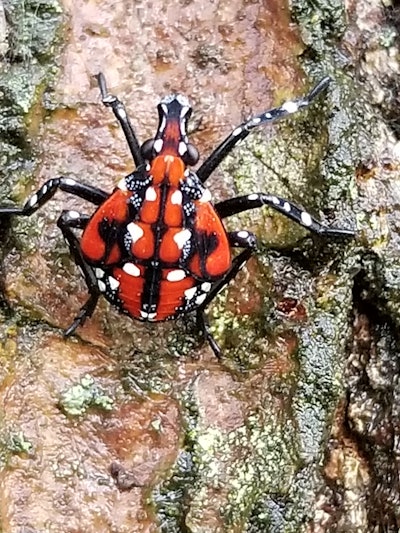 Fourth instar nymphs are distinct due to their red coloration.
Fourth instar nymphs are distinct due to their red coloration.Photo: Don Grosman
As for spray applications, in order for these to be effective at all, it is important to spray at the proper time. Grosman says that spray applications prior to early July are not worth the effort due to the fact the nymphs scatter quickly to find succulent plant material like annuals and perennials to feed on as they develop.
He advises waiting until the end of June or early July before conducting tree treatments, as this when the later instar nymphs and adults will begin feeding on trees.
“Currently, what we do is mainly focus on getting them more at the adult phase when they tend to congregate on certain trees that become hot so that we get the most bang for our buck on the insecticides,” Walsh says. “It’s too ubiquitous to go out and spray everything. The insect is extremely mobile, especially in the younger nymph stages and the early adults are extremely mobile. You can go back the next day and they’ll be on completely different plants from when you found them the day before. There’s so many that you can’t just keep spraying and spraying. Right now, our main current strategy is to focus on the stages of life where we know that they’re going to be concentrated.”
Walsh says that they can’t predict which trees of the favored species will become hot, as a homeowner could have five of the same tree species in a row, but the spotted lanternflies may only target one of these.
“At that point, we use systemic insecticides on those trees and knock them down before they get a chance to lay eggs,” Walsh says.
IMA-jet is one systemic injection treatments that has been found to successfully provide full season protection by killing both nymphs and adults, reducing honeydew and sooty mold on trees.
How to stop the spread
The Pennsylvania Department of Agriculture (PDA) has a quarantine that regulates the movement of plants, plant-based materials and outdoor household items that might have egg masses on them, but even despite this, the spotted lanternfly is incredibly mobile.
 Adult spotted lanternflies have a red hind wing that can be seen when flared.
Adult spotted lanternflies have a red hind wing that can be seen when flared.Photo: Don Grosman
They tend to travel more when in search of their preferred host trees. In September, these searches can turn into veritable swarms of flying adults.
“Nobody can stop lanternflies from coming onto your property,” Walsh says. “When the adults are flying, the sky can fill up and it looks like a biblical plague. You can’t stop more from moving in.”
One major concern is how the population has now spread to the Philadelphia area and are nearing the waterfront where there are both ships and railroad stations.
“The adults can now land on those ships and railroad cars, lay eggs and then be transported to any one of a number of different locations,” Grosman says. “That’s going to be a big issue in the near future. The prospects of them moving across the country is pretty high. Those egg masses are cryptic, so trying to find them all is going to be difficult.”
If a landscaper does find egg masses, depending on the amount of material they can either scrape these off or burn the material.
“Inspect what you’re doing,” Walsh says. “Make sure you aren’t shipping live insects as well. Inspect your materials and be vigilant about it.”
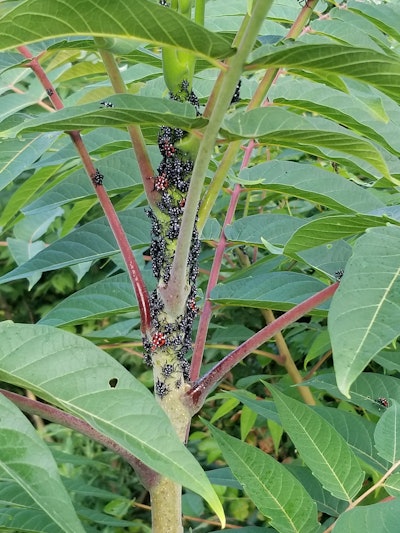 Spotted lanternfly nymphs gather on an Ailanthus tree.
Spotted lanternfly nymphs gather on an Ailanthus tree.Photo: Don Grosman
Currently, the PDA is working to reduce the amount of tree of heaven in areas and treating the remaining population of Ailanthus with a systemic insecticide in order to lower the spotted lanternfly population in hopes of eradicating the insect eventually.
Both Grosman and Walsh disagree with the PDA’s decision to only target the tree of heaven.
“They’re only focusing on the Ailanthus tree, and I think that’s a very myopic focus,” Walsh says. “It’s a much more complicated insect than that. If you work on those late falls prior to egg-laying times, I think you can have a better effect. Best thing I can say is be aware, look around, if you find it, report it to your local agencies, and from there do everything you can to stop the population from reproducing.”
“Even if they eliminate or eradicate tree of heaven, they’re just going to move on to some other less favorable tree but still sufficient to allow them to reproduce,” Grosman says. “This insect, in my opinion, is here to stay. I don’t see how they will be able to eradicate it. It’s just developed too far. Ultimately, probably the best answer to the problem is trying to introduce a natural enemy, like a parasite or predator or some type of fungal pathogen that would kill the insects en masse.”
 Egg masses about to hatch develop into egg pods.
Egg masses about to hatch develop into egg pods.Photo: Don Grosman
Yet even then he doesn’t believe a natural enemy could be a complete cure, but it might slow the spread.
“It’s out of the bag,” Walsh says. “Now we need to be looking at it more as a chronic condition rather than trying to get this eradication concept enacted. It’s not going to happen at this point.”
Despite this rather bleak outlook, Walsh advises landscapers not to panic and to focus on educating their customers so they aren’t fooled by the claims of less scrupulous businesses.
“My advice is, get ready,” Walsh says. “It’s more than likely going to show up in your area before too long if you’re anywhere near the Mid-Atlantic, and have a plan in place and start making your customers aware now so that you don’t have to explain it all from the beginning when it hits.”

